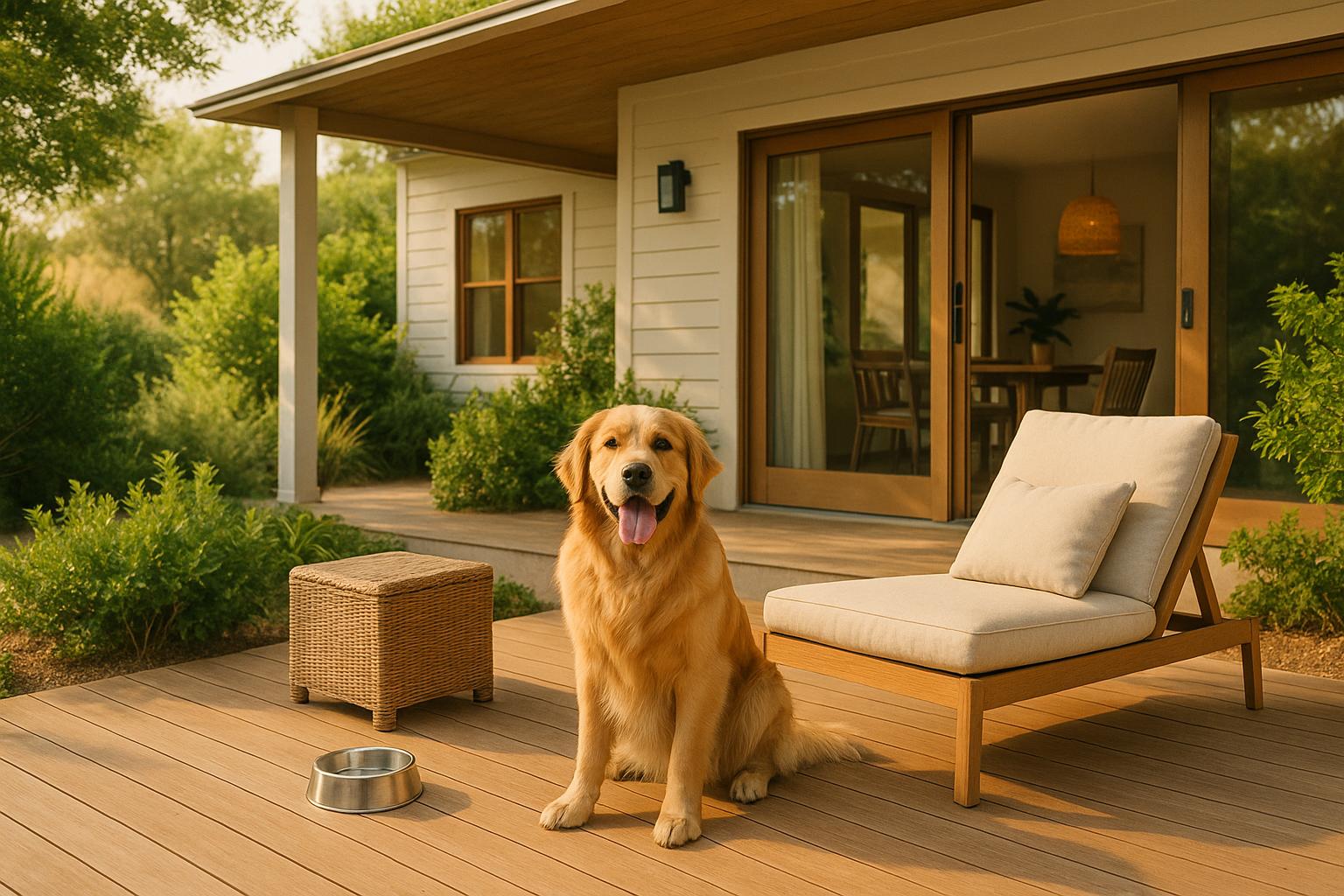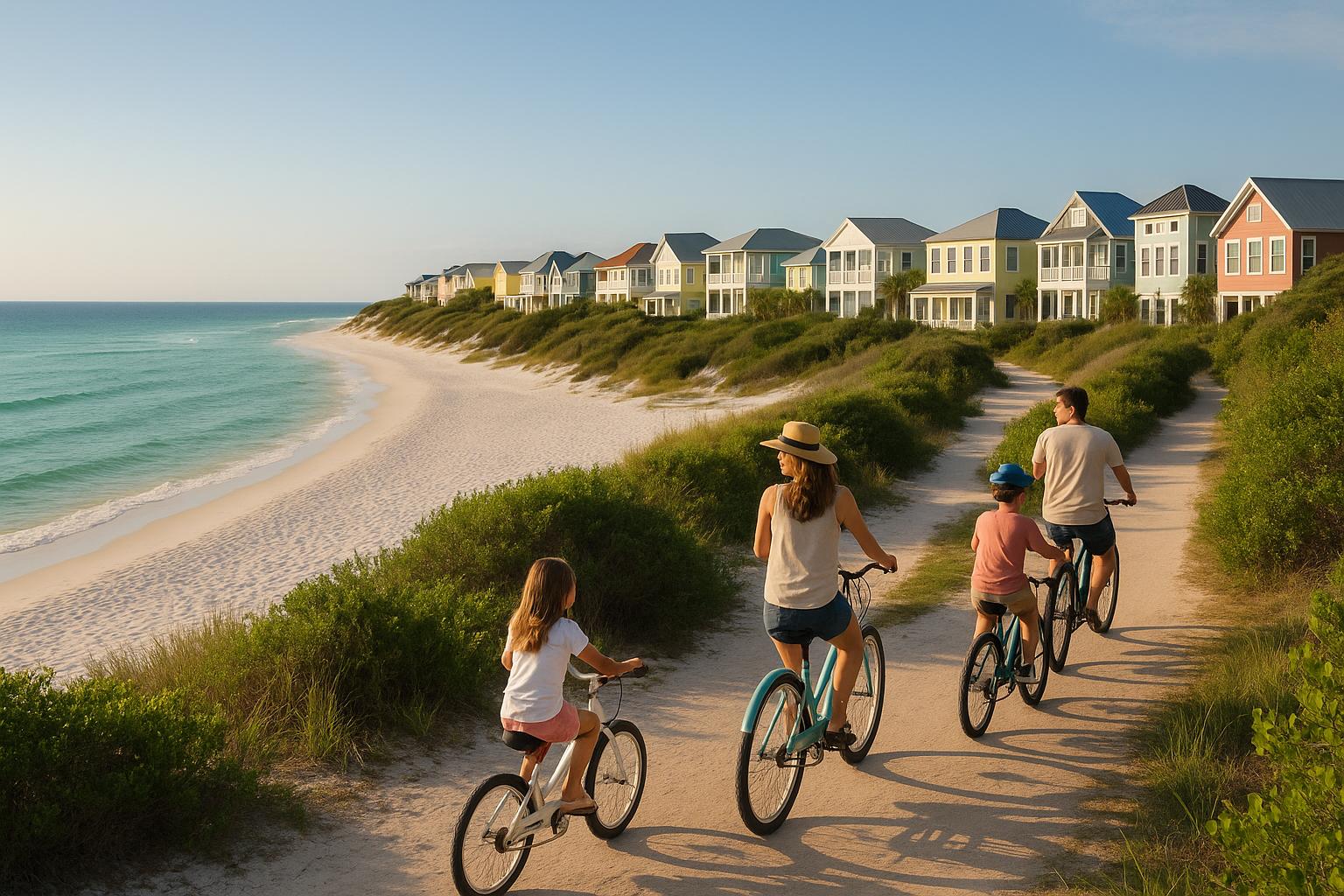Senior living in 2025 is focusing on safety through technology, design, and community connections. Here’s what’s shaping the future of senior care:
- Tech Integration: Smart home systems, wearable devices, and telehealth platforms are reducing risks like falls and improving healthcare access. For example, motion-sensor lighting and fall detection cameras have cut fall-related hospitalizations by 18%.
- Design Improvements: Memory care units now feature calming layouts and secure wandering paths, while energy-efficient buildings improve air quality and withstand natural disasters.
- Policy and Training: Staff training, digital compliance tools, and data-driven risk management are reducing incidents like medication errors and falls by up to 30%.
- Social Engagement: Programs for social interaction and family communication tools address isolation, which is linked to serious health risks like stroke and dementia.
Facilities combining these elements are creating safer, more connected environments for seniors while supporting their independence and well-being.
7 Trends in Senior Living that Will Define 2025 and Beyond
Technology-Based Safety Improvements
Technology is reshaping safety and independence in senior living communities. Tools like smart home devices, wearables, and telehealth platforms create a round-the-clock safety net for residents.
Smart Home Features
Voice-activated assistants such as Alexa and Google Assistant allow residents to control lights, thermostats, and appliances without lifting a finger, helping to reduce the risk of falls. Motion-sensor lighting brightens pathways during nighttime movements, while smart thermostats ensure a comfortable environment and even monitor for unusual activity.
In January 2025, SRG Senior Living introduced smart home systems in 400 California units. These upgrades included Alexa devices, motion-sensor lighting, and Kami Fall Detect Cameras. The result? An 18% drop in fall-related hospitalizations and a 22% boost in resident satisfaction within six months. The cost of these integrations ranged from $129 to $499 per unit.
Wearable technology takes these safety measures even further by offering real-time monitoring and instant emergency alerts.
Wearable Devices and Fall Detection
Devices like the Apple Watch Series 8 ($399–$499) and Oura Ring Gen 3 ($299–$399) are game-changers in senior safety. They provide continuous health monitoring and can send emergency alerts instantly. For room-based solutions, the Kami Fall Detect Camera ($89–$129) uses advanced technology to differentiate between routine activities and actual emergencies.
Infrared monitoring systems are particularly effective in memory care units. In February 2025, a senior community in South Orange County implemented infrared monitoring, which led to a 40% faster caregiver response time and a 60% decrease in privacy complaints from residents. Currently, over 60% of senior living communities use wearable health monitors, giving caregivers real-time data to take proactive steps when needed.
Adding to these advancements, telehealth solutions are breaking down barriers to healthcare access.
Telehealth and Virtual Care
Telehealth platforms have revolutionized senior care by enabling routine check-ups, chronic disease management, and mental health counseling - all from the comfort of home. Between 2020 and 2025, telehealth usage in senior living communities grew by over 40%. The monthly cost for these services typically falls between $20 and $50 per resident.
One standout example is Heisinger Bluffs Senior Living, which launched a telehealth initiative for 250 residents in March 2025. Within three months, off-site medical visits dropped by 35%, and access to care improved by 28%. Virtual care is especially beneficial for residents with mobility challenges or chronic conditions, as it reduces exposure to infectious diseases while maintaining consistent healthcare access.
For families exploring senior living options in areas like South Walton and the 30A coastline, these technological advancements are becoming key decision factors. Platforms like sowal.co provide helpful insights into communities that prioritize safety and well-being through technology.
Safety-Focused Design and Construction
Modern senior living communities are designed with a focus on safety and well-being, striking a balance between reducing risks and encouraging independence.
Memory Care and Cognitive Support
In memory care settings, thoughtful design plays a crucial role in supporting residents. Features like calming color schemes, intuitive layouts, and secure wandering paths help reduce confusion, maintain dignity, and promote independence. Clear wayfinding and familiar surroundings are key elements, with straightforward floor plans that minimize disorientation and visual cues that aid navigation. Secure wandering paths allow residents to move freely and safely, while outdoor spaces are designed to provide therapeutic benefits without compromising safety.
Some communities in South Orange County go a step further by incorporating discreet monitoring systems, which allow residents to maintain autonomy while ensuring safety. Common areas are also carefully designed, using non-stimulating colors and familiar elements to create a comforting, homelike atmosphere that supports cognitive health.
Energy-Efficient and Healthy Construction
Senior living communities are increasingly adopting healthy building practices that not only enhance safety but also lower operational costs. Advanced HVAC systems improve indoor air quality, while low-VOC and non-toxic materials reduce respiratory risks. Enhanced insulation, smart climate controls, and energy-efficient lighting ensure comfortable temperatures throughout the year. Many communities aim to meet high health standards by pursuing WELL and LEED certifications.
These measures help reduce respiratory issues and prevent heat-related problems, contributing to residents' overall well-being. In coastal areas like South Walton, additional design considerations include hurricane-resistant construction and efficient cooling systems, ensuring safety and comfort in challenging climates. Outdoor spaces are also prioritized, encouraging year-round physical activity and social engagement.
Flexible Housing Models
Flexible housing options are another hallmark of modern senior living communities. The continuum of care model allows residents to transition seamlessly between independent living, assisted living, and memory care - all within the same campus. This approach is especially valuable for couples with differing care needs, enabling one partner to receive memory care while the other remains in assisted living. This arrangement helps preserve relationships and minimizes the stress of relocation.
Modular housing designs further enhance adaptability by accommodating changes in mobility and care needs. For example, individual living spaces can be modified to include wheelchair-accessible bathrooms. These flexible solutions provide peace of mind for residents and their families by reducing the likelihood of future moves.
sbb-itb-d06eda6
Safety Through Policies and Training
Safety in senior living communities isn't just about cutting-edge technology and thoughtful design - it also hinges on having strong policies and well-trained staff. While advanced tools and smart design create safer environments, the human element remains a critical factor. Comprehensive policies and skilled personnel form the foundation of effective safety programs, ensuring quick responses to emergencies and consistently high standards of care.
Staff Preparedness and Training
Annual safety drills and scenario-based simulations play a key role in preparing staff, reducing injuries, and boosting residents' confidence. These training programs go beyond standard emergency procedures, immersing staff in real-world scenarios to sharpen their readiness for unpredictable situations.
Modern training blends digital learning modules with hands-on practice. Staff members undergo competency assessments to ensure they can handle emerging risks like infectious diseases or cybersecurity challenges. This blended approach - combining in-person drills, online lessons, and peer-led workshops - keeps teams well-prepared. Involving staff in shaping safety policies through regular refresher courses and feedback sessions not only enhances their skills but also reinforces their commitment to maintaining a safe environment.
Regulatory Compliance Tools
Digital compliance management systems have revolutionized how senior living communities handle evolving safety regulations. These platforms automate reminders for mandatory training, generate compliance reports, and provide real-time updates on regulatory changes. This ensures communities stay ahead of requirements, avoid penalties, and uphold top safety standards.
Features like automated alerts and centralized documentation make it easy for administrators to update policies and demonstrate compliance. For example, during the rapid shifts in COVID-19 protocols, digital systems allowed immediate updates to procedures and training materials, keeping staff informed and compliant. By tracking certifications and documenting safety measures automatically, these tools lighten administrative workloads while improving overall safety outcomes. They also set the stage for data-driven risk management strategies.
Risk Management Strategies
Data-driven approaches are now helping senior living communities reduce incidents significantly. According to Liberty Mutual's senior care claims study, falls account for more than 50% of liability claims in these communities, with medication errors and healthcare-related incidents also posing major risks.
Key strategies include using standardized medication administration protocols with electronic tracking and conducting regular audits of care practices. Communities that integrate digital compliance systems with ongoing staff training have seen incident rates drop by 20-30%.
Risk assessments, informed by data from incident reports and wearable devices, help communities identify patterns and address hazards proactively. For instance, a facility in South Orange County introduced infrared monitoring in memory care units, leading to a noticeable reduction in nighttime falls. Similarly, another community streamlined staff training through digital compliance tools, cutting medication errors by 30% within a year.
The Centers for Disease Control and Prevention (CDC) reports that over one in four Americans aged 65 and older falls annually. However, communities with strong fall prevention training and technology have achieved up to a 40% reduction in fall-related injuries. Electronic medication management systems have also lowered medication error rates by 20-30%.
In regions like South Walton, where hurricanes are a concern, communities can use local resources and digital guides like sowal.co to address area-specific risks. By incorporating these localized insights into staff training and resident education, communities can ensure they’re prepared for unique challenges while maintaining a comprehensive approach to safety.
Building Community Connections for Safety
Strong social ties within senior living communities play a key role in promoting safety. The World Health Organization has highlighted social isolation among older adults as a serious health risk, linking it to higher rates of stroke, anxiety, dementia, and even early mortality. When community bonds are strong, residents are more likely to report safety concerns, participate in safety programs, and look out for one another. Below, we’ll explore how structured activities and digital tools nurture these vital connections.
Social Engagement and Intergenerational Programs
Organized activities aren’t just fun - they create essential safety networks. Research shows that seniors who regularly engage in social activities experience a 30% lower risk of depression and a 25% lower risk of cognitive decline compared to those who are more isolated. Activities like group exercise classes, hobby clubs (gardening, art, etc.), shared meals, and volunteering opportunities encourage participation and help residents form friendships. These connections provide emotional stability and allow neighbors to notice and act on health changes, ensuring timely intervention.
Programs that bring generations together have shown especially positive results. Collaborations with local schools or youth groups allow seniors to mentor younger individuals, share stories, and engage in joint activities. These interactions brighten moods, reduce loneliness, and offer cognitive benefits. Plus, they create a broader support network that can quickly identify and address safety concerns.
For those who prefer or need virtual options, online games, virtual museum tours, and video calls offer ways to stay connected.
The CDC notes that social isolation can increase the risk of early death from all causes, a risk comparable to smoking, obesity, and inactivity. Communities with strong engagement programs report fewer emergencies and higher satisfaction among residents.
Family Communication Tools
In addition to in-person activities, digital communication tools keep families and care providers closely connected. Modern platforms have evolved to do more than just share updates - they allow families to actively participate in care routines. Tools like Caremerge, MyFamilyChannel, and PointClickCare provide features such as daily updates, medication reminders, and direct messaging between staff and families. These tools enable families to stay informed about residents’ health and activities in real time, making it easier to address concerns and collaborate with care teams.
For instance, in 2023, a senior living provider introduced a family communication app that included real-time updates, video call scheduling, and care planning features. Over six months, family satisfaction scores increased by 40%, and resident participation in social activities grew by 25%.
These platforms are designed to work across various devices, making it simple for families to stay involved, even from a distance. In areas like South Walton, Florida, local resources can further strengthen these connections. For example, families can use guides like sowal.co to find community events, dining spots, and activities, making in-person visits more meaningful.
To ensure these tools are effective, technology training is essential. Communities that offer thorough training for both residents and families see higher adoption rates and better outcomes. Privacy regulations, such as HIPAA, must also be followed to ensure these tools enhance safety without compromising personal information.
Conclusion: The Future of Senior Living Safety
The future of senior living safety is shaping up to be a blend of smart technology, adaptable care models, and stronger community ties. These advancements aim to boost independence while maintaining a high level of protection for seniors.
Technology continues to lead the way in enhancing safety. For instance, AI-powered fall detection systems like SafelyYou have shown impressive results, cutting falls by 40% and reducing emergency room visits by 80% in participating communities. This kind of comprehensive safety monitoring is becoming a standard feature in senior living facilities nationwide.
Another key trend is the shift toward housing models that offer multiple care levels within the same community. These setups allow residents to transition seamlessly as their needs evolve over time, providing both convenience and continuity.
Social engagement also plays a critical role in safety and well-being. Studies show that regular social interactions can reduce the negative effects of isolation on mental health and cognitive function. Digital tools now make it easier for seniors to stay connected with their families, even from a distance, fostering a sense of belonging and emotional security.
For families considering a move to areas like South Walton and the 30A region, these safety innovations are particularly appealing. Advanced monitoring systems, versatile care options, and engaging social programs ensure that seniors can enjoy both security and a vibrant lifestyle. Coastal communities like South Walton and 30A offer unique opportunities for seniors to thrive, and resources such as sowal.co can help families find facilities that prioritize these forward-thinking safety measures.
The importance of these strategies is backed by data. According to the CDC, more than one in four Americans aged 65 and older experiences a fall each year, and social isolation has been linked to severe health risks like stroke and dementia. Addressing these challenges with comprehensive approaches not only tackles immediate safety concerns but also supports long-term health and wellness.
Looking ahead, the most successful senior living communities will be those that combine advanced technology with personalized, human-focused care. These environments will not just prevent accidents - they’ll empower seniors to live independently and confidently. By integrating smart technology, thoughtful design, and meaningful community connections, the future of senior living safety promises to enhance quality of life while preserving autonomy.
FAQs
How do smart home technologies and wearable devices improve safety for seniors in living communities?
Smart home technologies and wearable devices are reshaping safety measures in senior living communities by introducing practical tools to monitor and safeguard residents. Smart home systems offer features like automated lighting, motion sensors, and voice-activated emergency assistance, all designed to respond swiftly to potential dangers. For instance, motion-activated lights can help prevent nighttime falls, while voice commands enable seniors to request help without needing to move.
Meanwhile, wearable devices such as smartwatches and health trackers add another layer of protection. These devices can monitor vital signs, detect falls, and use GPS tracking for seniors who may wander. They also provide instant alerts to caregivers or emergency services, ensuring help arrives when it’s needed most. Combined, these technologies create a safer and more attentive environment tailored to the unique challenges seniors face.
What modern design features are improving safety and cognitive support in senior living communities?
Modern senior living communities are embracing cutting-edge design elements to prioritize safety and promote cognitive well-being. Among these advancements are smart home technologies like automated lighting systems, voice-controlled assistants, and fall detection devices. These tools not only improve convenience but also help minimize potential hazards.
Communities are also incorporating wayfinding features, such as clear signage and color-coded pathways, to make navigation simpler for residents dealing with memory challenges. Beyond that, details like non-slip flooring, ergonomic furniture, and upgraded security systems are ensuring that seniors can enjoy a secure and comfortable environment. These thoughtful updates are shaping safer and more supportive spaces for older adults as we move into 2025 and beyond.
How do social engagement programs and digital tools enhance the safety and well-being of seniors in senior living communities?
Social engagement programs and digital tools are transforming the lives of seniors in senior living communities by enhancing both their well-being and safety. These programs encourage residents to connect with one another, easing loneliness and boosting mental health. At the same time, digital tools - like emergency response systems, wearable health trackers, and virtual communication platforms - add an extra layer of security and convenience. They help seniors stay in touch with loved ones and caregivers while preserving their independence.
By blending technology with community-driven initiatives, senior living communities are creating spaces where emotional and physical well-being are top priorities. This approach ensures seniors feel safe, supported, and connected in their everyday lives.



